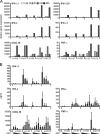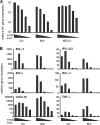Pandemic H1N1 2009 influenza A virus induces weak cytokine responses in human macrophages and dendritic cells and is highly sensitive to the antiviral actions of interferons
- PMID: 19939920
- PMCID: PMC2812319
- DOI: 10.1128/JVI.01619-09
Pandemic H1N1 2009 influenza A virus induces weak cytokine responses in human macrophages and dendritic cells and is highly sensitive to the antiviral actions of interferons
Abstract
In less than 3 months after the first cases of swine origin 2009 influenza A (H1N1) virus infections were reported from Mexico, WHO declared a pandemic. The pandemic virus is antigenically distinct from seasonal influenza viruses, and the majority of human population lacks immunity against this virus. We have studied the activation of innate immune responses in pandemic virus-infected human monocyte-derived dendritic cells (DC) and macrophages. Pandemic A/Finland/553/2009 virus, representing a typical North American/European lineage virus, replicated very well in these cells. The pandemic virus, as well as the seasonal A/Brisbane/59/07 (H1N1) and A/New Caledonia/20/99 (H1N1) viruses, induced type I (alpha/beta interferon [IFN-alpha/beta]) and type III (IFN-lambda1 to -lambda3) IFN, CXCL10, and tumor necrosis factor alpha (TNF-alpha) gene expression weakly in DCs. Mouse-adapted A/WSN/33 (H1N1) and human A/Udorn/72 (H3N2) viruses, instead, induced efficiently the expression of antiviral and proinflammatory genes. Both IFN-alpha and IFN-beta inhibited the replication of the pandemic (H1N1) virus. The potential of IFN-lambda3 to inhibit viral replication was lower than that of type I IFNs. However, the pandemic virus was more sensitive to the antiviral IFN-lambda3 than the seasonal A/Brisbane/59/07 (H1N1) virus. The present study demonstrates that the novel pandemic (H1N1) influenza A virus can readily replicate in human primary DCs and macrophages and efficiently avoid the activation of innate antiviral responses. It is, however, highly sensitive to the antiviral actions of IFNs, which may provide us an additional means to treat severe cases of infection especially if significant drug resistance emerges.
Figures




References
-
- Cantell, K., and J. Pirhonen. 1996. IFN-gamma enhances production of IFN-alpha in human macrophages but not in monocytes. J. Interferon Cytokine Res. 16:461-463. - PubMed
-
- Coccia, E. M., M. Severa, E. Giacomini, D. Monneron, M. E. Remoli, I. Julkunen, M. Cella, R. Lande, and G. Uze. 2004. Viral infection and Toll-like receptor agonists induce a differential expression of type I and lambda interferons in human plasmacytoid and monocyte-derived dendritic cells. Eur. J. Immunol. 34:796-805. - PubMed
-
- Dawood, F. S., S. Jain, L. Finelli, M. W. Shaw, S. Lindstrom, R. J. Garten, L. V. Gubareva, X. Xu, C. B. Bridges, and T. M. Uyeki. 2009. Emergence of a novel swine-origin influenza A (H1N1) virus in humans. N. Engl. J. Med. 360:2605-2615. - PubMed
-
- de Jong, M. D., C. P. Simmons, T. T. Thanh, V. M. Hien, G. J. Smith, T. N. Chau, D. M. Hoang, N. V. Chau, T. H. Khanh, V. C. Dong, P. T. Qui, B. V. Cam, Q. Ha do, Y. Guan, J. S. Peiris, N. T. Chinh, T. T. Hien, and J. Farrar. 2006. Fatal outcome of human influenza A (H5N1) is associated with high viral load and hypercytokinemia. Nat. Med. 12:1203-1207. - PMC - PubMed
Publication types
MeSH terms
Substances
LinkOut - more resources
Full Text Sources
Medical

